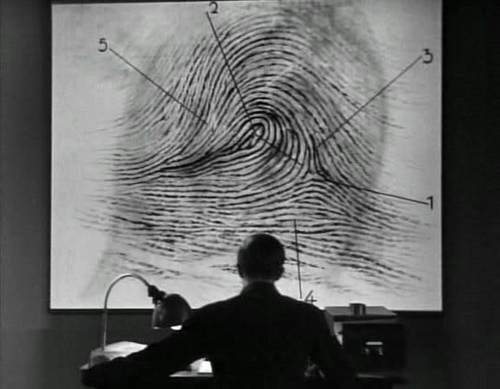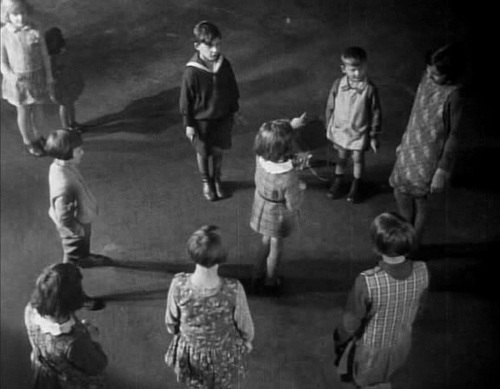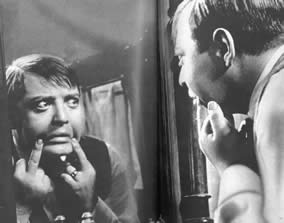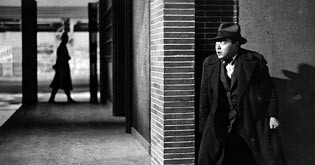| From the Chicago Reader (August 8, 1997). Also reprinted in my collection Essential Cinema. — J.R. |
M
Rating **** Masterpiece
Directed by Fritz Lang
Written by Thea von Harbou, with Paul Falkenberg, Adolf Janesen, Karl Vash, and Lang
With Peter Lorre, Otto Wernicke, Gustaf Grundgens, Ellen Widman, Inge Landgut, Ernst Stahl-Nachbaur, Franz Stein, and Theodor Loos.
It’s unthinkable that a better movie will come along this year than Fritz Lang’s breathtaking M (1931), his first sound picture, showing this week in a beautifully, if only partially, restored version at the Music Box. (The original was 117 minutes, and this one is 105 — though until the invaluable restoration work of the Munich Film Archives, most of the available versions were only 98.) Shot in only six weeks, it’s the best of all serial-killer movies — a dubious thriller subgenre after Lang and three of his disciples, Jacques Tourneur (The Leopard Man, 1943), Alfred Hitchcock (Psycho, 1960), and Michael Powell (Peeping Tom, 1960), abandoned it. M is also a masterpiece structured with the kind of perfection that calls to mind both poetry and architecture and that makes even his disciples’ classics seem minor by comparison.
M came at a privileged juncture in history — the period when silent movies were giving way to talkies, dividing the art of cinema into two distinct kinds of narrative flow: the flow of images, intertitles, and music that achieved a kind of apotheosis in the late 20s and early 30s in pictures such as Dovzhenko’s Earth, Lang’s Spione, Murnau’s Sunrise, Vidor’s The Crowd, Chaplin’s City Lights, Sternberg’s The Docks of New York, and Stroheim’s unfinished Queen Kelly; and the flow of dialogue, narration, music, and sound effects that carried images along like uprooted trees and houses in a flood. Like only a few other pictures in this exciting transitional period — Dreyer’s Vampyr, Ozu’s The Only Son, Sternberg’s Thunderbolt and The Blue Angel, and Dovzhenko’s Ivan are the first that come to mind — M draws mightily on both of these powerful strains, picking and choosing from the best of both. Building its story on visual rhymes that are carried by dialogue that periodically turns into offscreen narration, and fusing the two great traditions of silent film — montage/editing and camera movement/mise en scene — this astonishing movie represents an unsurpassed grand synthesis of storytelling.
Lang himself correctly maintained to the end of his life that M was his best film — not so much for its formal beauty as for the social analysis that its form articulates. (In Jean-Luc Godard’s 1963 Contempt — another restoration that will open at the Music Box a month from now, in which Fritz Lang plays himself — this point is underlined when he first meets Brigitte Bardot’s character, who expresses enthusiasm for his western Rancho Notorious; Lang graciously replies, “I prefer M.”) He also, according to film historian and programmer David Overbey (who knew him during his last years), tended to change the subject or grouse whenever the name Orson Welles came up. It’s an understandable reaction; in spite of all the pages wasted on the alleged influence of Stagecoach or The Power and the Glory on Citizen Kane, M is clearly — visibly and audibly — the major predecessor of that movie’s low and high angles, its baroque and shadowy compositions, its supple and wide-ranging camera movements, its tricky sound and dialogue transitions, and above all its special rhythmic capacity to tell a “detective story” by turning most of its characters into members of a chorus, delineating a social milieu and penetrating a dark mystery at the same time. (Welles claimed never to have seen any of Lang’s German work when he started making movies, and many of his stylistic moves surely emerged from his theater and radio work. But it would be difficult to look at Citizen Kane again without thinking of M repeatedly.)
I’m still inching my way through Patrick McGilligan’s recently published, 548-page Fritz Lang: The Nature of the Beast, but it’s already apparent that this first posthumous biography of Lang follows pretty much the same kitchen-sink principle as Frank Brady’s Citizen Welles: it’s both spotty as scholarship and invaluable as a treasury of sources and suppositions. McGilligan doesn’t know German and is often sloppy when it comes to making attributions, but he has the merit of being candid about his uncertainties — most of them compounded by Lang’s lifelong talent for embroidery and mythmaking. So this isn’t a work of solipsistic indulgence or spiteful invention, like David Thomson’s recent execrable Welles biography, Rosebud, and it’s a better read than Todd McCarthy’s Howard Hawks: The Grey Fox of Hollywood, because the career it describes is a good deal more shrouded in mysteries and ambiguities.
The standard story about Lang’s flight from Germany in 1933, repeatedly told by Lang from 1942 on, is that shortly after the Nazi banning of his second talkie, The Testament of Dr. Mabuse, he was summoned to the office of master Nazi propagandist Joseph Goebbels, who offered him the job of running the Nazi film industry. Keeping his eye on the clock and hoping to make it to his bank in time, Lang conspired to leave the country for good the same day. But a few years ago Lang’s passport came to light, revealing that he made many subsequent trips back to Germany over the next three months, and no mention is made in Goebbels’s detailed diaries of this alleged meeting or offer.
We’ll probably never know the full story, but the important facts are that Lang was central to the German film industry before and during the Nazis’ rise to power and that he did flee from Germany in 1933, leaving behind his estranged and pro-Nazi wife Thea von Harbou — the principal writer of all his films in the 20s and 30s, including M. And the complex analysis of urban German society offered in M, clearly influenced by Brecht’s Threepenny Opera, offers a fascinating look at that society and what it was becoming. (“Organization” is a key word here; it’s also where the film’s resemblance to architecture comes in.)
As a city is terrorized by the crimes of a deranged murderer of little girls, not only the police but other criminals and even beggars, threatened by the panic that puts everyone under suspicion, decide they have to help track the culprit down to protect their own interests. Lang steadily crosscuts between the efforts of these three separate factions, the public at large, and the murderer himself (Peter Lorre), graphically describing each stage of the pursuit and at the same time exposing the inner life of the city. Arguably, no other thriller has so effectively combined exposition and suspense with a portrait of an entire society, and M does this through a dazzling system of visual rhymes and aural continuities, spatial leaps and thematic repetitions, that virtually reinvents the art of movie storytelling.
In keeping with the collectivist spirit of the early 30s, social organization and narrative organization work hand in hand here; they even become indistinguishable insofar as organizing a manhunt is what the city and the story both do. In an early sequence a taunting letter from the murderer to a city newspaper is published, and we move straight from the letter in the paper to a state minister (Franz Stein) reading it while arguing over the phone with the chief of police (Ernst Stahl-Nachbaur), who’s seen in separate shots. As the police chief describes his department’s investigation, his voice turns into narration over a striking montage illustrating his various points. One of these points takes us to police headquarters, where a detective is questioning two irate, competing witnesses — each a vivid character sketch — about whether the bonnet worn by a potential murder victim that morning was red or green; a crisply edited comic interlude concludes with one witness snapping, “Of course, inspector, if you’re willing to listen to a socialist…” — one of many details missing from most previous versions of M.
Another of the chief’s points refers to the police archives, and after the film cuts to an official in the archives dictating a report about the criminal mind to a secretary, this dictation picks up the chief’s narration, which we then hear over a shot of the murderer himself in his apartment — making faces and contorting his features in front of a mirror, as if playfully trying on the stereotypes that the report is proposing about him. Watching the murderer, it’s easy to assume that he’s responding to the voice of a radio announcer, but this may be because the movie’s ingenious system of turning dialogue into narration (and sometimes vice versa) carries one along so quickly that one sometimes participates in the storytelling process by inventing details of one’s own.
One might say that Lang is positing the collective voice of the city as his storyteller as well as his subject — a collective social voice that’s juxtaposed with the lone voice of the murderer, tonelessly whistling a theme from Edvard Grieg’s Peer Gynt as his eerie signature. (Because Lorre was unable to whistle, it was Lang himself who whistled — anticipating the close-ups of his own hand in many subsequent features when close-ups of hands were needed.) Although the social sense that makes all this collective consciousness possible seems far removed from our own era, every link in the collective chain is strikingly individualized: none of the mobs in this film is faceless. Furthermore, the film’s patterns of rhyme and continuity set up an implicit process of analysis in which good and evil, innocence and corruption, intelligence and stupidity, all become relative values within the same complex tapestry.
We might assume that the murderer, the only person operating exclusively as an individual, is pure evil and that his pursuers — police, criminals, beggars, panicky street pedestrians — are all relatively innocent. And Lang allows us to sustain this bias for most of the picture, working on our sense of dread about the barely known killer, but raising a few doubts along the way. For instance, various clusters of people on the street suggest potential lynch mobs when they settle on innocent bystanders as suspicious; and the murderer himself — a childlike gnome called Hans Beckert — is revealed to us so gradually that we aren’t able to perceive him as a fully defined individual until the end. But by the time all the separate factions, including the murderer, are climactically brought together, we identify with Beckert in spite of ourselves, recoiling, as he does, from the angry mob that confronts him. Thanks to Lorre’s volcanic performance, this is one of the most terrifying and emotionally wrenching extended sequences ever filmed, and the moral, ethical, and social questions it poses are virtually identical to the arguments we hear today about serial killers and what we should do with them.
Part of the awesome effect of this sequence derives from the fact that it’s the only truly extended sequence in the film, as well as the only one that depends entirely on spatial and temporal continuity. Until this point the film leaps back and forth across the city, from one smoke-filled room or crowded or empty street scene to another — showing how similar cops and crooks can be while planning their strategies or charting their separate interactions with the beggars, the community, or each other. The oratorical hand gesture begun by Schranker (Gustaf Grundgens), head of the underworld, at one strategy meeting where he says, “I’m appealing to you…” is completed by the police chief at another strategy meeting, where he says, “for advice.” The point of making this continuity cut isn’t to imply that the crooks and cops are identical, but to point out that they’re similar in certain respects, even to the point of having common interests. It’s an analysis that brilliantly serves triple duty by traversing the city and advancing the plot at the same time.
At times the camera movements are just as purposeful in serving these multiple ends. Our introduction to the Beggars Market occurs during the same sequence, after we’ve passed back and forth between Inspector Lohmann (the charismatic Otto Wenicke) at the police meeting and Schranker at the crooks’ hideout. When Schranker argues the need for enlisting spies who can root out the killer undetected (he and his cohorts are portrayed as shadows on a wall), he finally settles on “Beggars. The beggars’ union.” Before we can puzzle out what sort of organized labor he’s talking about, a brilliant long take answers the question in detail: the camera leads us from an array of collected cigar and cigarette butts arranged by beggars on a table (a detail missing from earlier prints) to a notice reading No More Credit to another table bearing scavenged pieces of bread and sausage to a closeup of beggars handling these items. Then comes a pan to a card game that eventually proceeds into another room — where we find a food counter and a blackboard listing the prices and ingredients of various sandwiches — and continues up to and through the window of a second-story office. (This inventory, I should add, omits many incidental and anecdotal details.) Not only is our question answered by this shot, but the rudiments of an entire organization and a way of life are unraveled in the process. At the end of the shot Schranker appears in the upstairs office to recruit beggars, which picks up the narrative again.
If Lang has a visual signature that can be followed throughout his career, it might be the analytical overhead shot — the high camera angle that postulates individuals as pieces in some sort of pitiless board game. M periodically uses that signature, the camera most often poised over the streets of the city at night — creating images that spell out the basics of noir long before anyone dreamed up that generic term. This signature is always part of an overall pattern, part of a game in which several players are involved. Yet the film’s climactic sequence occurs in a dark basement, and basements, subterranean caves, and dungeons are every bit as operative in Lang’s vision as his overhead shots, defining the limits of his universe. The remainder of his movies are more commonplace, generally concerning everyday life as it’s ordinarily lived between those boundaries.
It’s easy, I suppose, to feel nostalgic about a time when an artist could dare to examine and embrace the entire life of a grand metropolis, from top to bottom, physically as well as psychologically. What I think I love most in M, emanating directly from the brilliance of its form, is its faith and confidence in the possibility of such an enterprise — speculating in the process on the havoc that one individual can wreak on an organism such as a city, then on the emotional havoc that organism can wreak on the individual. It assumes a kind of naive faith in the world we live in as something that can be seen, heard, and ultimately grasped, at least up to a point. Beyond that point is merely terror — a metaphysical terror connected to the vastness of the unknown, perceived as the daunting enormity of overhead and underground spaces — something that M also acknowledges and exploits to the utmost.
In a universe ruled by video and cyberspace, where such assumptions can no longer be entertained or even easily imagined, the terror remains, but not the mission to see the world whole. (Lang took a halfhearted stab at this in his last film — The Thousand Eyes of Dr. Mabuse, which involves former Nazis and video surveillance and was made back in Germany in 1960 — but hardly anyone was interested at the time.) Maybe we’ll have real stories like M again, and better ways of telling them, once we’ve rediscovered more precisely what it is that we’re missing.






